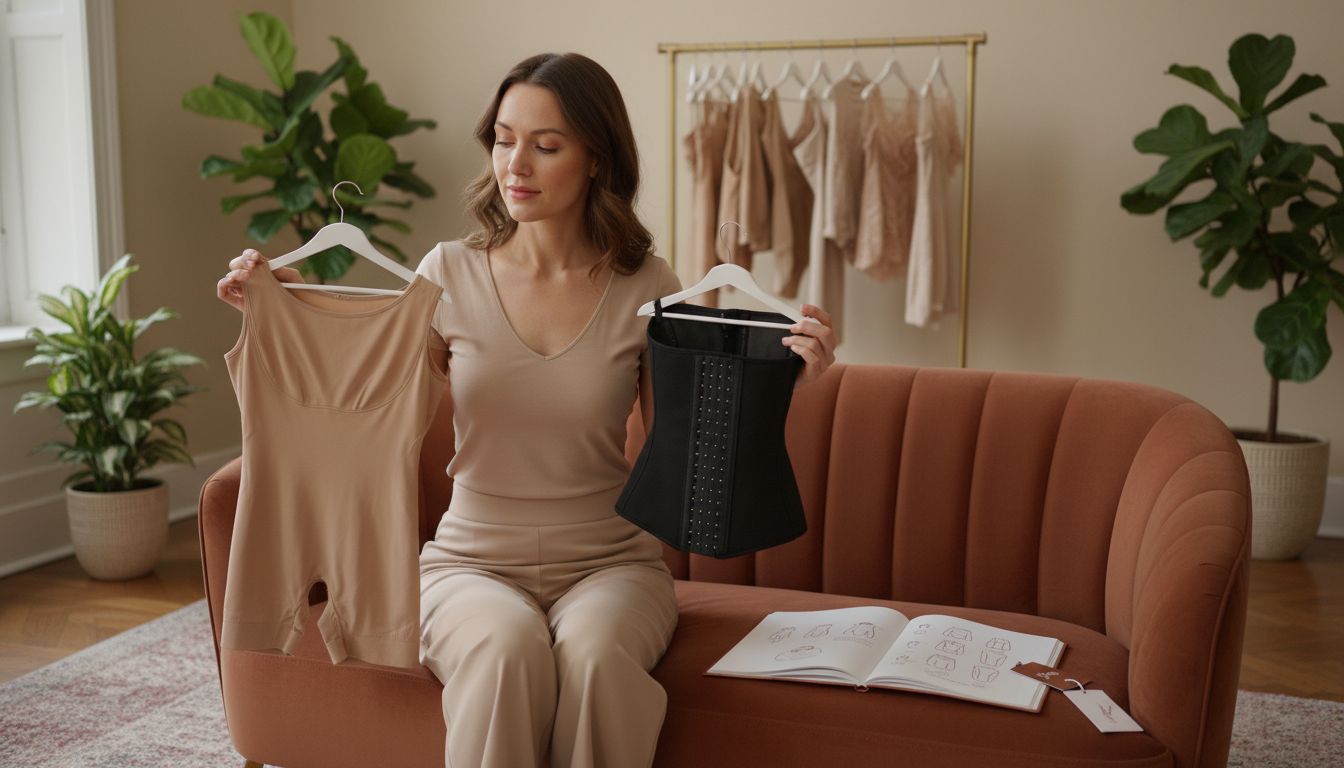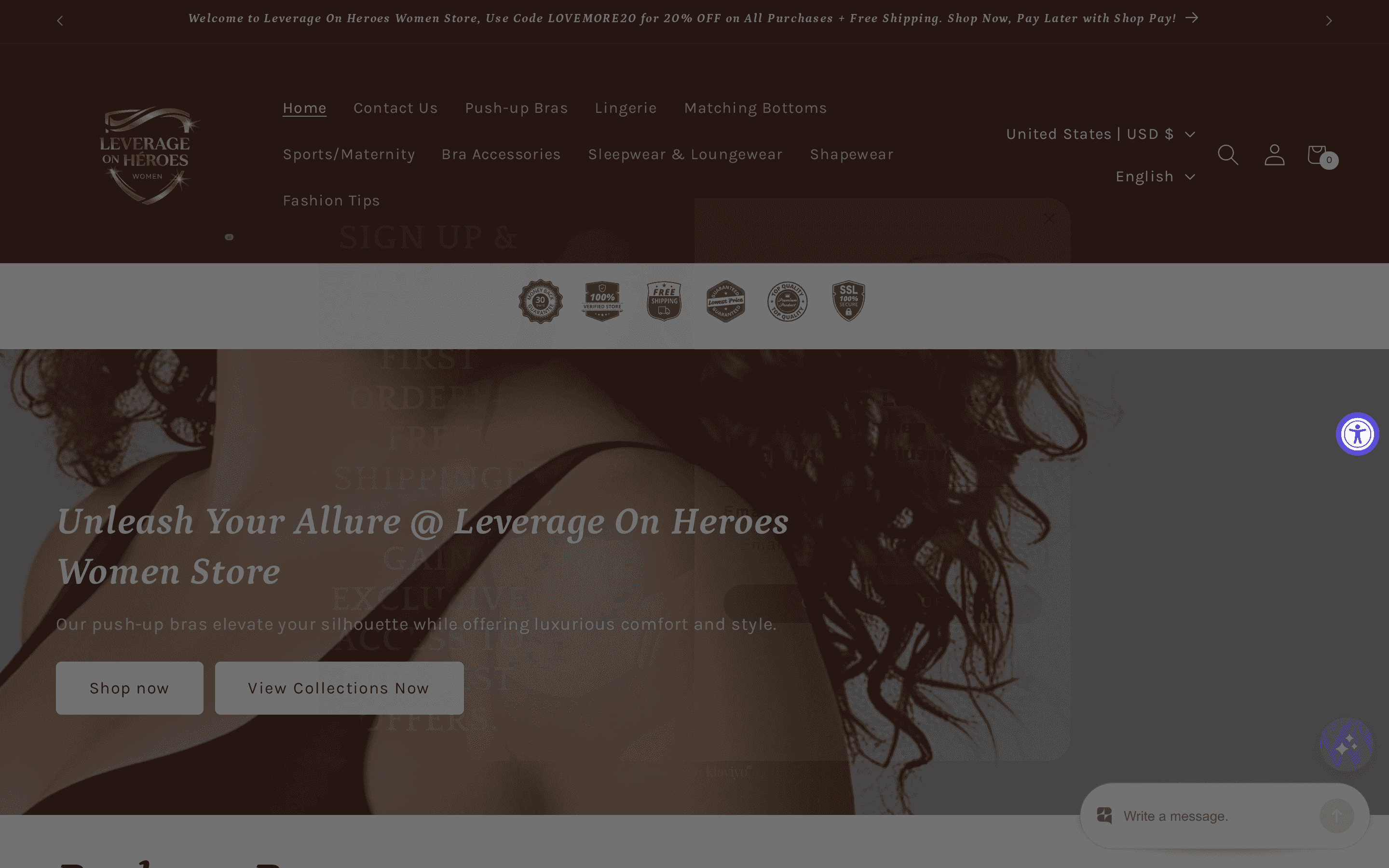
Body Shapers vs Waist Trainers: Complete Guide
Partager
Almost 60 percent of women have tried some form of body contouring garment to smooth or reshape their appearance. The quest for a sleeker silhouette is more common than many realize, driving interest in body shapers and waist trainers of all kinds. Whether you want all-over smoothing or a more defined waistline, understanding how these garments work helps you choose the right solution for comfort and confidence.
Table of Contents
- Body Shapers and Waist Trainers Defined
- Types and Common Styles Explained
- How Body Shapers and Waist Trainers Work
- Health Benefits and Potential Risks
- Choosing the Right Option for Your Needs
Key Takeaways
| Point | Details |
|---|---|
| Body Shapers vs. Waist Trainers | Body shapers provide overall body contouring, while waist trainers focus specifically on waist reduction through targeted compression. |
| Compression Mechanics | These garments work by redistributing body mass to enhance appearance, yet the effectiveness depends on material, design, and intended use. |
| Health Considerations | While compression garments can improve posture and confidence, improper use may lead to significant health risks, including respiratory and digestive issues. |
| Selecting the Right Garment | Choosing the appropriate shapewear requires alignment with individual body goals, comfort, and desired coverage area for optimal effectiveness. |
Body Shapers and Waist Trainers Defined
When it comes to body contouring garments, two popular options stand out: body shapers and waist trainers. According to research from Wikipedia, foundation garments like body shapers are designed to provide support and enhance a wearer’s silhouette by smoothing and contouring various body areas.
Body shapers are compression undergarments crafted to create a streamlined appearance. They typically cover multiple body zones - from the torso to the thighs - offering comprehensive shaping and support. Unlike targeted garments, body shapers work to redistribute body volume, creating a more uniform and polished look under clothing.
Conversely, waist trainers serve a more specific purpose. As explained by Wikipedia, these are specialized garments focused on modifying body shape, particularly targeting the waistline through consistent compression. Waist trainers often feature more rigid construction, sometimes incorporating steel or plastic boning to provide structured compression around the midsection.
Key differences between these garments include:

- Body shapers offer full-body or multi-zone contouring
- Waist trainers concentrate exclusively on waist reduction
- Body shapers are typically more flexible and comfortable
- Waist trainers provide more intense, targeted compression
For women seeking comprehensive understanding, our guide on shapewear types provides additional insights into these transformative garments.
Types and Common Styles Explained
Body shapers and waist trainers come in a diverse range of styles designed to meet different body shaping needs. According to Wikipedia, foundation garments encompass multiple types including corsets, girdles, control panties, body shapers, and thigh shapers, each strategically targeting specific body areas for optimal support and contouring.
Full-Body Shapers provide comprehensive coverage from bust to thighs, creating a smooth silhouette under form-fitting clothing. These garments typically feature seamless construction and varying levels of compression to redistribute body volume evenly. They’re perfect for achieving a streamlined look in evening gowns, fitted dresses, and professional attire.
A specialized style worth highlighting is the hourglass corset. As detailed by Wikipedia, this design specifically aims to create a dramatically contoured silhouette by emphasizing a narrow waist while accentuating bust and hip curves. Modern hourglass shapers blend traditional corset principles with contemporary comfort technologies.
Common shaper styles include:
- High-Waisted Shorts: Targeting lower abdomen and thigh areas
- Bodysuits: One-piece garments offering full torso compression
- Waist Cinchers: Narrow compression bands focusing on midsection
- Compression Tanks: Upper body shaping with built-in support
For those seeking deeper insights into selecting the right shapewear, our guide on shapewear types offers comprehensive recommendations tailored to different body types and style preferences.
How Body Shapers and Waist Trainers Work
Body shapers and waist trainers are ingenious compression garments designed to transform body contours through strategic pressure application. According to Wikipedia, these foundation garments function by compressing and redistributing body mass to create a smoother and more contoured appearance under clothing.
Compression Mechanics are the primary working principle behind these garments. Waist trainers, in particular, apply targeted pressure to the midsection. As detailed by Wikipedia, training corsets work by applying consistent pressure to the waist area, gradually reducing its circumference and potentially altering the body’s shape over time. This process involves carefully engineered fabric and structural design that provides firm yet flexible support.
The effectiveness of these garments depends on several key factors:
![]()
- Material Composition: Typically blend of elastic, nylon, and spandex
- Compression Levels: Ranging from light smoothing to intense body modification
- Structural Design: Strategic paneling and boning for targeted shaping
- Breathability: Ensuring comfort during extended wear
Understanding how these garments interact with your body is crucial. Some redistribute fat and tissue, while others provide immediate visual smoothing. For women wanting to explore more nuanced shapewear techniques, our guide on everyday shapewear offers comprehensive insights into selecting the right compression garment.
Health Benefits and Potential Risks
Body shapers and waist trainers offer both potential benefits and notable health considerations that every woman should understand before incorporating them into her wardrobe. According to Wikipedia, while these garments can provide support, excessive use may lead to significant health issues including difficulty breathing, digestive problems, and potential permanent bodily deformation.
On the positive side, compression garments can offer several health advantages when used appropriately. These include improved posture, temporary muscle support, and enhanced body confidence. Some individuals experience reduced lower back strain and improved spinal alignment through strategic compression. However, the key is moderation and proper sizing to prevent unintended physiological stress.
The potential risks associated with prolonged or incorrect use are substantial. As highlighted by Wikipedia, tight waist trainers can cause immediate discomfort and long-term health complications if worn improperly. Critical risks include:
- Restricted Breathing: Compression limiting lung capacity
- Digestive Disruption: Potential interference with normal organ function
- Muscle Weakness: Potential dependency and muscle atrophy
- Skin Irritation: Prolonged friction and moisture retention
For women seeking to understand shapewear’s nuanced impact, our guide on everyday shapewear provides comprehensive insights into safe and effective use of compression garments.
Choosing the Right Option for Your Needs
Selecting the perfect body shaper or waist trainer requires careful consideration of your individual body goals and comfort requirements. According to Wikipedia, selecting the appropriate foundation garment depends on the desired level of control, comfort, and the specific areas of the body one wishes to shape or support.
Body Composition and Goal Alignment play crucial roles in making the right choice. Different compression garments serve distinct purposes - some focus on overall smoothing, while others target specific problem areas like the waist, abdomen, or thighs. Your primary objective could be improving clothing fit, enhancing posture, or achieving a more streamlined silhouette. Understanding your body’s unique needs helps narrow down the most suitable option.
When evaluating potential shapewear, Wikipedia emphasizes the importance of considering factors like material strength, fit, and intended duration of wear. Key selection criteria include:
- Compression Level: Light, medium, or firm control
- Material Flexibility: Breathable fabrics versus rigid structures
- Coverage Area: Full-body, mid-section, or targeted zones
- Comfort and Mobility: Ensuring unrestricted movement
For women seeking personalized guidance on finding their ideal shapewear solution, our guide on everyday shapewear offers comprehensive insights into matching compression garments with individual body types and style preferences.
Find Your Perfect Fit With Confidence
Choosing between body shapers and waist trainers can feel overwhelming when you want the right support without sacrificing comfort. This guide highlights the key differences and helps clarify how each garment shapes your silhouette, boosts your confidence, and fits into your lifestyle. Whether you are targeting full-body smoothing or focused waist compression you deserve a solution that works for your unique goals and comfort needs.
Discover our carefully curated collection of Shapewear designed to provide effortless support while enhancing your natural curves.

Embrace a new level of confidence and comfort today. Visit the Leverage On Heroes Women Store to explore styles tailored to your body and lifestyle needs. Take control of your look now by choosing shapewear that fits like it was made just for you.
Frequently Asked Questions
What is the difference between body shapers and waist trainers?
Body shapers offer full-body or multi-zone contouring to provide a smooth and uniform look, while waist trainers focus specifically on reducing waist size through targeted compression.
How do body shapers work?
Body shapers work by compressing and redistributing body mass to create a streamlined appearance. They feature flexible materials that provide support without significantly restricting movement.
Are there any health risks associated with wearing waist trainers?
Yes, prolonged or improper use of waist trainers can lead to health issues such as restricted breathing, digestive problems, muscle weakness, and skin irritation. It’s essential to follow guidelines for safe usage.
How do I choose the right body shaper for my needs?
Choosing the right body shaper involves considering your body composition and specific goals, such as the level of compression, desired coverage area, and comfort during wear.
Recommended
- Bodysuit Shapewear vs Waist Trainers: What’s Better for Everyday Wear? – Leverage On Heroes Women Store
- Shapewear vs Regular Underwear: Complete Guide – Leverage On Heroes Women Store
- Shapewear Function Explained: The Essential Guide – Leverage On Heroes Women Store
- 7 Essential Types of Shapewear Every Woman Should Know – Leverage On Heroes Women Store
- How to Choose Swimwear in 2025: Guide for Women – Be Juliet
- 7 Safest Weight Loss Supplements for Fitness Success – MyGymSupplements
